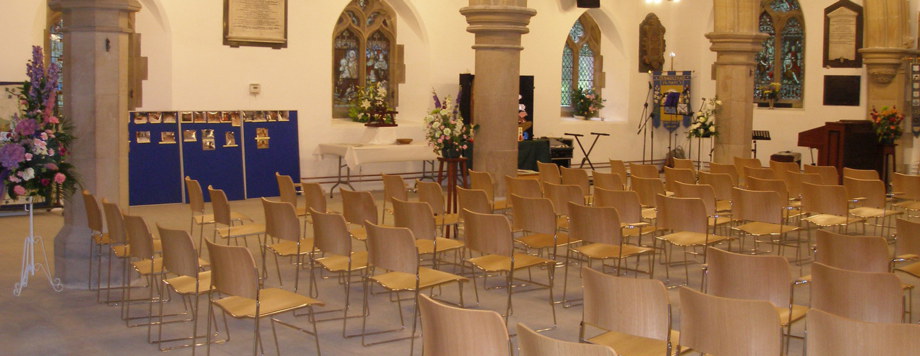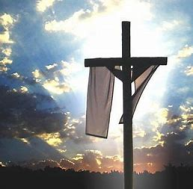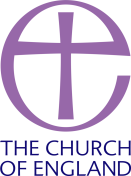
The Church in its Historical Setting
The Barony of Penwortham
Penwortham became in the 12th century the head of a Barony held by Warin Bussell. It was part of the crown property sequestered by William the Conqueror. William parcelled it out to his follower
Roger de Poitou; Roger in his turn passed it on to his follower, Warin, who became the first Baron. The Barony included a large part of Leyland Hundred and many manors outside it. In
1205, after a dispute between King John and Hugo Bussel, the fourth Baron, the title was granted by the King to Roger de Lacy, Constable of Chester. It passed through the Earls and Dukes of Chester
and Lincoln to Thomas, Earl of Lancaster, whence it was merged with the superior Title of Duke of Lancaster and the Crown.
Courts Baron continued to be held at Penwortham together with the Manorial Courts Leet, and it is known that at last one Baron, Ranulph de Blundeville, Earl of Chester, held court at Penwortham
Castle. The courts became extinct relatively recently, near the end of the 19th century.
As the Barony was extensive, so it was that the Courts drew on a large area. In 1625 suit and service were demanded from the following townships:
In Leyland Hundred
Anderton, Brethrton, brindle, Charnock Richard, Clayton, Coppull, Croston, Cuerden, Duxbury with Adlington, Eccleston, Euxton, Gunolfsmoors, Hoghton with Withnell, Leyland, Longton, Penwortham,
Roddlesworth with Wheelston and Heapey, Standish with Langtree, Ulnes Walton, Welch Whittle, and Whittle
In West Derby
Kirkdale and North Meols
In Amounderness
Carleton, Claughton, Elswick, Freckleton, Kellamergh, Newton with Scales, Warton, and Whittingham
Judgers were sent from Bolton and Prees. A list of 1836 adds the following townships to join those which at
one time or another had to present suit and service at Penwortham’s court baron:
Bryning, Charnock Goggard or Heath Charnock, Hambleton, North Meols, Shevington, and Worthington.
The Priory, its Priors, and the Penwortham Breviary
The Priory
Warin Bussel, the first Baron of Penwortham, was married to Matilda, a lady who held land in Evesham (Worcestershire), and had made gifts to the Abbey of that town. Her affection for the Abbey
no doubt continued when she and her husband arrived at Penwortham and found expression in generosity towards Penwortham Priory, a cell or offshoot of Evesham Abbey.
Warin Bussel transferred to the Abbey certain lands and benefices and in return the Abbey undertook to serve Penwortham Church with three monks and a Chaplain, and to accept one of Warin’s sons as a
monk.
Prior of Penwortham was not an exalted position; to be at Penwortham in any capacity was looked on by the monks as a form of penance. Over the years of its existence, the Priory did mange to attract
four characters of some interest:
The generous Prior Wilcote set up a bequest which provided funds to feed the monks. This was very necessary, for some monastics in those days were not above embezzling from the common funds even the
means of survival.
The learned Adam Sortes was perhaps the Priory’s most distinguished resident. He had fled from Evesham in 1207 to escape persecution by Roger Norris who, unfortunately, later came to Penwortham
himself. This Roger –“Black Roger”, he was called – began his muddy career at Canterbury, where he was imprisoned, after betraying his fellow monks. He escaped through a sewer, and perhaps
having deceived the King with his pompous manner and literary skill, was made Abbot of Evesham by the king’s command. Here he satisfied his greed by means of embezzlement and misappropriation; he
thus deprived the monks in his care of all but the barest food and clothing. In 1213 he was deposed by the Papal Legate and put in charge of Penwortham; in the following year his behaviour led to his
ejection from even this post. He was reinstated in 1219 to Penwortham – but out of pity and not because of any new found virtue; he remained at Penwortham for the last six years of his life;
unreformed, unrepentant, irreconcilable. Nearer in time to the Reformation we have another black sheep – Prior Hawkesbury was reported by the Commissioners Leigh and Layton for his (sexual)
incontinence. By that time there was only one other monk at the Priory.
With the Dissolution of the Monasteries imminent, Penwortham had already begun its decline. Early in 1539, the Abbot of Evesham leased the Manor, Monastery, Parsonage, Tithes and everything except
the advowson of Leyland Church, to John Fleetwood, of Little Plumpton, near Kirkham.
Of the actual building, little is known, except that it was of wood, and included a chapel, and stood between the junction of Hollinhurst Avenue and Priory Crescent and the corner in Monks Walk. The mediaeval Priory was replaced by a Tudor building. The ruins of this latter were themselves replaced by a mansion in the Gothic style, built 1813-1835 and demolished in 1926 to make way for private houses.
The Priors
The place-names attached to the different priors are names which occur predominantly in the Midlands or near West Country.
1159 to -1164 Henry
1180 to 1195 William of Winchcombe
1194 to 1207 Robert of Appleton
1207 to 1213 Adam Sortes
1213 to 1214 Roger Norris
1218 to 1223 Roger Norris
Circa 1226 John
Circa 1255 Thomas of Gloucester
Circa 1270 Philip of Neldesle
1282 to 1316 Walter of Walcote
1320 Ralph of Walcote
1321 Thomas of Blockley
1332 to 1341 Ralph of Wilcote
1350 Ralph of Whately
1371 Roger
1383 William of Mershton
1385 Thomas of Newbold
1397 John of Gloucester
1399 Thomas
1409 John of Gloucester
1422 Thomas Hanford
1436 Thomas
1472 John Power
1477 John Staunton
1502 Robert Yatton
1507 James Shrokerinton
1515 to 1516 Richard Hawkesbury
1535 to 1539 Richard Hawkesbury
The Breviary
Regular church services in the Middle Ages were the Mass (for monastics, clergy and people) and the Canonical Hours Services (for monastics and clergy).
The Canonical Hours Services – Mattins and Lauds, Prime, Terce, Sext, None, vespers and Compline – were the services on which the Anglican Morning and Evening Prayer ( Mattins and Evensong) are
based. Short services spread throughout the day – of psalms, canticles, lives of the saints. Bible readings, set sermons, sung responses, hymns and prayers – they were obligatory for
monastics and clergy. And while the component parts of the Mass were set out in a book called the missal, the component parts and ordering of theses services were set out in a book called a
Breviary.
The Penwortham Breviary, which has passed through many hands since being used at Penwortham, follows the Use of Sarum. This is the ordering of church services pioneered by Bishop Osmund, used by
Salisbury Cathedral and adopted throughout the Province of Canterbury by 1542 – at which time both Penwortham and the mother House were in that Province. Written in clear and regular Gothic script,
in black and red, the Penwortham Breviary can be dated about 1310. On one of the pages is a note, dated 1486 and written by Thomas Harwode, Chaplain to the parish Church. It presents the manuscript
to Saint Mary’s and warns that if the Breviary is used for teaching boys to sing, then it should not be left in their charge “and through their carelessness be reduced to nothing in a few
years”!
In 1964 the British Museum Quarterly included an article about the Penwortham Breviary, an extract of which is given below.
The Breviary came up for sale in 1963 and was acquired by the British Museum, where it is occasionally on view. Photographs of some of the pages of the Breviary can be viewed on-line at the
British Library website.
The Manors
After Henry VIII had dissolved the Monasteries and put them at his own disposal, he sold to Joh Fleetwood in 1543 the Manor which John had earlier leased from the Abbot of Evesham. This Manor
remained in the hands of the Fleetwood (except for a brief period in the 17th century when it was sequestered by Parliament) until in 1746 Henry Fleetwood died childless and in debt. By a special Act
of Parliament (1748) the estates were sold to John Aspinall in 1749 and he sold them to James Barton of Ormskirk.
Now the manor of Hutton had in 1546 been granted to a Lawrence Rawstorne of Old Windsor, and it was his descendant, Col. Lawrence Rawstorne who in 1783 bought from James Barton the Manor of Penwortham including the old Priory. From then on until the estate was broken up into a housing suburb in the early 20th century, the Squire of Penwortham was always called Lawrence Rawstorne. The connection of the Rawstornes with Penwortham is maintained in that the present Patron of the Benefice is Alicia Wild (nee Rawstorne). Part of the property which remained in the hands of the Bussel family came into the possession of the Faringtons of Worden in the 19th century.
The Children- Division of the Parish
The Ancient Parish of Penwortham was very extensive, and over the years has given birth to four new Parishes.
Longton
Reference was made to “the priest of Longton” in a deed of 1150 but the area was not served continuously from then on. Sometimes it was served by a clerk, sometimes by the Master of Hutton School.The
first Minister to use the title “Vicar” was the Rev’d Lawrence Preston in 1852. The PCC was formed in 1922 and legal separation was formalised in 1938. Thus ended a long process, begun when people
realised that the flooding of Mill Brook made it very often impossible for the parishioners of Hutton and Longton to get to Penwortham Church, so the brook, by Howick School, forms the
boundary. The worshippers of Hutton and Longton first used a chapel at Hutton, which existed in about 1200 at a place called Ulvedene, perpetuated by the name Chapel Hill. The present church at
Longton (St Andrew’s), designed by J.E.K Cutts and built in 1887, replaced an earlier Chapel built close by which itself replaced an earlier building in 1773.
Farington
This is a younger parish, and was separated more rapidly, largely because of Victorian industrial development in he area. A District was assigned to it by Order in Council in 1843, and it became a
full parish on the retirement of the then Vicar of Penwortham in 1858. The Church (St. Paul’s) designed by Sharpe was built 1839-40 and the chancel, by Seward of Preston, was built
1909-10.
New Longton
The area was designated a Conventional District in 1916, became a “Peel Parish” in 1928 and a full Parish in 1931. A cottage for worship was rented in 1866 and a small chapel was built in the
following year. A larger, temporary chapel was dedicated in 1917 and the present Church (All Saints), designed by T. Mellor, was dedicated in 1964.
St. Leonard’s, Penwortham
Designated a Conventional District in 1959, the area became a separate parish in 1972.
Until the iron church was built at the beginning of the 20th century services were held in the “Chapel Room” of the school. A new church, designed by Lilley and Kirkham, was dedicated in 1970. It was
damaged by fire in 1973 but quickly repaired.
Province, Diocese and Deanery
Until the 10th century all of Lancashire was in the province and Diocese of York. From that century until just before the Reformation, the part of the County south of the Ribble (including
Penwortham) was in the Province of Canterbury and Diocese of Lichfield.
In 1541, Penwortham was incorporated in the newly formed Diocese of Chester. This diocese spent a year in Canterbury Province, but in 1542 was transferred to the Province of York. From
then on, Penwortham has remained in the province of York, but at the beginning of 1848 was included in the new Diocese of Manchester, and early in 1927 was included in the new Diocese of
Blackburn.
From the earliest references to it, Penwortham has been included in the Deanery of Leyland.
The Clergy of Penwortham
Until the Dissolution, Penwortham Church was supplied with a Chaplain from the nearby Priory. After the Dissolution the first clergyman whose name we know lived at Penwortham in about 1580.
Until the middle of the 17th century the clergyman was always known as “Curate”. From then on until the early 19th century, he was called “Minister”, although Henry Rycroft in 1675 felt it
appropriate to style himself “Rector”. From 1832, Penwortham has had an “Incumbent”, and from 1868 it had a “Vicar”.




